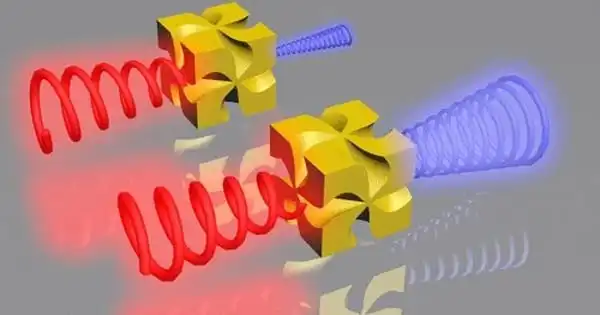Chirality is crucial in the fields of chemistry, pharmacology, biology, and medicine. Recently, it has been proposed that chirality will play an important role in nano-biotechnology. Chirality is one of the most fascinating natural occurrences. A chiral molecule has two mirror-image forms that are not superimposed in three dimensions. Enantiomers are the mirror-image forms of the chiral molecule. Chirality is crucial in the fields of chemistry, pharmacology, biology, and medicine. Chirality is also a key factor in molecular recognition, which has numerous applications in chemistry and biology.
Using artificial chiral metamaterial, researchers were able to amplify the nonlinear response. The new technology enhances the possible applications of mirror symmetry by amplifying chiral nanoparticle signals.
In the mirror, the left hand appears to be the right hand, but the left-handed glove does not fit on the right hand. Chirality is the property of an object that cannot be superimposed on its mirror image. This property of molecules is important in pharmaceutical research because it has the potential to make drugs toxic.
Because these molecules and mirror-symmetrical molecules have the same physical properties, general optical analysis cannot tell them apart. Polarized light, which spins in different directions, must be used instead. Furthermore, when the molecular size is small compared to the wavelength of light, the chiral interaction between light and molecules is very weak, making measurement difficult.
We measured the chiral linear scattering and second harmonic generation (SHG) scattering of a newly developed chiral nanoparticle. SHG is a phenomenon in which light with twice the frequency (2ω) of the incident light (ω, omega) is generated. The majority of chiral nanoparticles emit a weak SHG signal, making measurement difficult.
Professor Junsuk Rho and Jungho Moon
A research team led by Professor Junsuk Rho and Jungho Moon (Department of Mechanical Engineering and Department of Chemical Engineering) at POSTECH in collaboration with Professor Ki Tae Nam and Dr. Hyeohn Kim (Department of Materials Science and Engineering) at Seoul National University and Professor Thomas Zentgraf (Department of Physics) at Paderborn University in Germany have together developed a technology to increase the chirality between light and nanoparticles using the metamaterial, known as the invisible cloak material.
When light is shone on chiral nanoparticles, a signal is produced, but it is very weak. As a result, several nanoparticles had to be collected in order to determine the average signal. To address this issue, the researchers were successful in synthesizing an artificial chiral material using metamaterials, which significantly strengthened the signal.

The researchers measured the chiral linear scattering and second harmonic generation (SHG) scattering of a newly developed chiral nanoparticle. SHG is a phenomenon in which light with twice the frequency (2ω) of the incident light (ω, omega) is generated. The majority of chiral nanoparticles emit a weak SHG signal, making measurement difficult.
The SHG signal of the chiral nanoparticles developed by the research team was found to be up to ten times greater than the linear case. This allows for the precise measurement of the mirror symmetry of a single nanoparticle as well as a very small amount of chiral material, and it is expected to contribute to the accurate structural analysis of chiral nanoparticles in the future.
The development of new chiral nanoparticles is of great interest not only for nanotechnology, but also for many other fields of scientific endeavor such as chemistry, biochemistry, pharmacology, and medicine. Furthermore, understanding the fundamental concepts related to chirality in nanosystems is critical for the advancement of nanoscience and nanotechnology in general. There were several interesting and useful reviews on chiral nanostructures during the last 3–4 years.
In this review, we hope to present some recent advances in the production and potential applications of various chiral nanostructured inorganic materials, such as metallic (plasmonic), semiconducting, metal oxide, and silica-based chiral nanomaterials, as well as new chiral hybrid nanostructures, made in the last three years.















